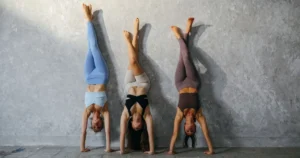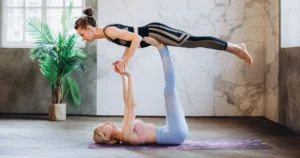Bikram Yoga Postures: A Comprehensive Guide to Enhancing Your Practice
Bikram Yoga, also known as hot yoga, is a popular form of yoga that involves a sequence of 26 postures performed in a heated room. This practice not only offers physical benefits but also promotes mental well-being. Whether you’re a beginner or an experienced practitioner, understanding the various Bikram Yoga postures and their benefits can greatly enhance your practice. In this article, we will explore these postures and delve into the profound effects they can have on your mind, body, and overall wellness.
Bikram Yoga, developed by Bikram Choudhury, is a unique style of yoga that consists of a series of 26 postures and two breathing exercises. The practice is performed in a room heated to approximately 105°F (40.6°C) with a humidity of 40%. The combination of heat and humidity helps to warm up the muscles, increase flexibility, and promote detoxification through sweat. It also allows for a deeper stretch and a more intense workout.
 Benefits of Bikram Yoga
Benefits of Bikram Yoga
Bikram Yoga offers a wide range of benefits for both the body and the mind. Some of the key advantages include:
- Improved Flexibility: The high temperature in the Bikram Yoga studio helps to loosen the muscles, allowing for greater flexibility and improved range of motion.
- Increased Strength: The various postures in Bikram Yoga work on different muscle groups, helping to build strength and tone the body.
- Enhanced Cardiovascular Health: The heat and intensity of the practice elevate the heart rate, providing a cardiovascular workout and improving overall heart health.
- Stress Relief: Bikram Yoga promotes relaxation and stress reduction by focusing on deep breathing and mindfulness. The practice encourages the release of endorphins, which elevate mood and induce a sense of well-being.
- Improved Mental Clarity: Regular practice of Bikram Yoga can enhance mental focus, concentration, and clarity, leading to increased productivity and a sharper mind.
You may also like.What are 10 Benefits of Doing Yoga Everyday?10 Effective Benefits
The 26 Postures of Bikram Yoga
Pranayama Breathing
1.Standing Deep Breathing
The Standing Deep Breathing posture is performed at the beginning of each Bikram Yoga class. It involves deep inhalation and exhalation to expand the lungs and increase oxygen intake, preparing the body for the subsequent postures.
2.Half Moon Pose with Hands to Feet Pose
This combination pose consists of two parts: Half Moon Pose and Hands to Feet Pose. Half Moon Pose stretches the entire side of the body, while Hands to Feet Pose helps improve flexibility in the hamstrings and lower back.
3.Half Moon Pose
Half Moon Pose, also known as Ardha Chandrasana, is a balancing posture that strengthens the legs, core, and ankles. It improves coordination and focus while opening the hips and stretching the hamstrings. In this pose, you extend one leg sideways while keeping the other leg grounded. The upper body leans to the side, creating a beautiful arc shape resembling a half moon.
Standing Series
4.Awkward Pose
The Awkward Pose is designed to strengthen the lower body, particularly the quadriceps, buttocks, and calves. It also improves balance and alignment.
5.Eagle Pose
Eagle Pose is a challenging balance posture that improves concentration and focus. It stretches the shoulders, upper back, hips, and thighs.
6.Standing Head to Knee Pose
The Standing Head to Knee Pose is a standing forward bend that strengthens the core, improves balance, and increases flexibility in the hamstrings.
7.Standing Bow Pose
Standing Bow Pose is an advanced backbend that opens the chest, strengthens the legs and ankles, and enhances spinal flexibility.
8.Balancing Stick Pose
Balancing Stick Pose is a dynamic posture that develops balance, strength, and endurance. It engages the entire body and improves posture.
9.Standing Separate Leg Stretching Pose
The Standing Separate Leg Stretching Pose stretches the hamstrings, calves, and lower back. It also improves circulation and digestion.
10.Triangle Pose
Triangle Pose strengthens the legs, opens the hips and chest, and stretches the hamstrings and groins. It also improves balance and concentration.
11.Standing Separate Leg Head to Knee Pose
This pose combines a forward bend with a side stretch. It stretches the hamstrings, hips, and lower back while improving balance and focus.
12.Tree Pose
Tree Pose improves balance, stability, and concentration. It strengthens the legs, ankles, and core muscles while promoting a sense of groundedness.
Floor Series
13.Toe Stand Pose
Toe Stand Pose is a challenging balance posture that strengthens the ankles and improves balance and focus. It also stretches the quadriceps and improves digestion.
14.Dead Body Pose
Dead Body Pose, also known as Savasana, is a relaxation pose performed at the end of each Bikram Yoga class. It allows the body to cool down and relax, promoting deep rest and rejuvenation.
Spine Strengthening Series
15.Wind Removing Pose
Wind Removing Pose gently massages the abdomen and digestive organs, aiding digestion and relieving constipation. It also stretches the lower back and hips.
16.Cobra Pose
Cobra Pose strengthens the back muscles, improves spinal flexibility, and stretches the chest and shoulders. It also helps to relieve back pain.
17.Locust Pose
Locust Pose strengthens the muscles of the lower back, buttocks, and legs. It improves posture, enhances digestion, and stimulates the abdominal organs.
18.Full Locust Pose
Full Locust Pose builds strength in the back muscles, glutes, and hamstrings. It also improves posture and enhances circulation.
19.Bow Pose
Bow Pose is a deep backbend that stretches the entire front of the body. It strengthens the back muscles and improves spinal flexibility.
20.Fixed Firm Pose
Fixed Firm Pose opens the hips and stretches the thighs, knees, and ankles. It increases flexibility in the lower body and improves digestion.
21.Half Tortoise Pose
Half Tortoise Pose is a resting posture that promotes deep relaxation and stress relief. It stretches the spine, shoulders, and hips.
22.Camel Pose
Camel Pose is a deep backbend that stretches the entire front of the body. It strengthens the back muscles, opens the chest, and improves posture.
23.Rabbit Pose
Rabbit Pose is a forward bend that stretches the spine and back muscles. It also stimulates the thyroid and parathyroid glands.
24.Head to Knee Pose with Stretching Pose
This combination pose involves a forward bend and a side stretch. It stretches the hamstrings, hips, and lower back, and improves digestion.
25.Spine Twisting Pose
Spine Twisting Pose increases spinal flexibility and stretches the back muscles. It also massages the abdominal organs and improves digestion.
26.Hands to Feet Pose
Hands to Feet Pose, also called Padahastasana, is a forward bend that deeply stretches the entire back of the body. It helps to improve flexibility in the spine, hamstrings, and calves. In this pose, you fold forward from the hips, reaching your hands toward your feet. The focus is on maintaining a straight spine and gently increasing the stretch over time. It also encourages relaxation and can provide relief from mild anxiety and stress.
Conclusion
Bikram Yoga postures offer a holistic approach to physical and mental well-being. By practicing these 26 postures regularly, you can experience improved flexibility, increased strength, enhanced cardiovascular health, stress relief, and improved mental clarity. Embrace the heat, challenge yourself, and enjoy the transformative power of Bikram Yoga.


 Benefits of Bikram Yoga
Benefits of Bikram Yoga

